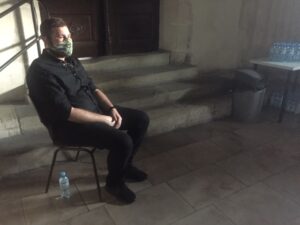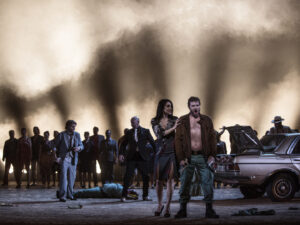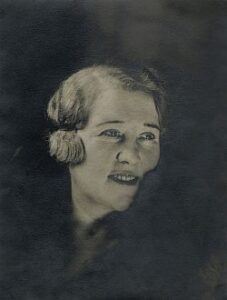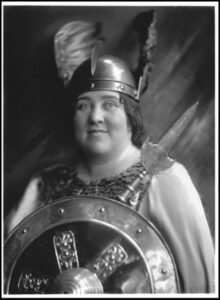Dawno nie miałam aż tak silnego poczucia, że funkcjonuję w jakiejś równoległej rzeczywistości. Pandemia ruszyła z kopyta, na co świat zareagował gremialnym pakowaniem walizek i rozjechaniem się we wszystkie strony na upragnione wakacje. Teatry operowe w krajach anglosaskich uprzedzają, że przymusowa przerwa może się przeciągnąć aż do 2021 roku, tymczasem Jonas Kaufmann fotografuje się w kumpelskim uścisku z innymi gwiazdami nadchodzącego spektaklu Aidy na Piazza del Plebiscito w Neapolu (jak trafnie skomentował pewien internauta, „What can possibly go wrong in Italy?”). Organizatorzy polskiego życia muzycznego wahają się między przeniesieniem wszystkiego do sieci a puszczeniem wszystkiego na żywioł. Będzie ciekawie. W większości oper i sal koncertowych w Europie wprowadzono drastyczne ograniczenia: zarówno krytycy, jak i melomani przebierają już nogami w długaśnych kolejkach, czekając na ostateczne decyzje o przydziale miejsc. Pocieszmy się – kierownicy działu organizacji widowni zawsze mieli pod górkę. O tym i o innych, do dziś aktualnych paradoksach życia muzycznego pisałam dokładnie dziesięć lat temu w jednym z mysich felietonów. A nuż kogoś rozbawi.
***
Tu jeszcze lato nie rozkwitło, a my poczuliśmy się całkiem niepotrzebni. Gospodarz naszej nory oświadczył, że już nas nie chce i może nas przekazać komuś innemu – wraz z norą i zobowiązaniami. Ser nam się kończy, nowy numer nie trafił o czasie do sprzedaży, więc się martwimy, przez co przegryzą się nasze prapraprawnuczęta. Trochę nam się humor poprawił, kiedy w numerze 5-6/1960 „RM” znaleźliśmy przepis na zwiększenie dystrybucji, zastosowany przy okazji VI Konkursu Chopinowskiego:
Bileterzy Filharmonii Narodowej sprzedają każdy numer naszego pisma w ilości 500 egzemplarzy w czasie przerw koncertowych. Na okres Konkursu „nakład” został podniesiony do 750 egzemplarzy. Kierownik organizacji widowni, pan Konrad Urbański, tak sobie radził z rozprzedażą:
Przed jego pokojem – długi ogonek klientów czekających na możliwość zdobycia wejściówki na przesłuchania. Wchodzi pierwszy interesant, student szkoły muzycznej.
– Panie Kierowniku, dwie wejścióweczki, sam jestem studentem klasy fortepianu, tak chciałbym posłuchać…
– Dobrze, oczywiście chętnie Panu załatwię… (kordialnie do studenta) A jak się Panu podobał ostatni numer „Ruchu Muzycznego”?
– Jeszcze nie czytałem…
– Jak to? Pan jeszcze nie czytał? To pan się zupełnie nie interesuje muzyką! Jak można chodzić na Konkurs, a nie czytać „Ruchu”? (ręka wypisująca już wejściówkę zatrzymuje się). Przepraszam, nie będę Panu mógł dać biletu…
Kiedy w długim ogonku czekających rozeszła się wiadomość o tej rozmowie, po chwili wszyscy stali z pismem muzycznym w ręku…
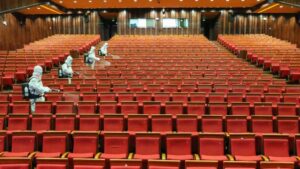
Fot. Getty Images
Ha! Aż nam się wierzyć nie chce, że połowa dzisiejszego nakładu rozprzedawała się w samej tylko FN. Choćby fortelem, ale i tak zazdrość… Kierownicy organizacji widowni nie muszą się dziś fatygować wypisywaniem wejściówek. Dość mają pracy z wypełnianiem zaproszeń – bo naprawdę niełatwo tak dobrać publiczność, by w fotelach nie zasiadł nikt zainteresowany muzyką. W razie czego mogą skorzystać z doświadczeń ABW i spytać, komu bardziej należy się miejsce w loży honorowej: abonentom „Linii Otwockiej” czy „Przeglądu Papierniczego”.
Inna sprawa, że Krystyna Rawicz sarkała już na ówczesnych bywalców Konkursu:
Sądzę, że nie odkryję Ameryki stwierdzając, że trzy czwarte sali to publiczność nigdy nie oglądana w filharmonii przez stałych bywalców – i to właśnie stanowi ów niecodzienny smaczek dla obserwatora. Z pasją teoretyka dzielę tych ludzi na różne kategorie.
Pierwsza grupa, typowo snobistyczna, traktuje filharmonię jak pewnego rodzaju „salon”, w którym wypada się „pokazać”. Można by snuć optymistyczne refleksje o wzroście kultury w społeczeństwie. Kilkadziesiąt lat temu tego rodzaju „obowiązkową” imprezą towarzyską było przyjęcie u hrabiego Iksa, dziś stał się nią konkurs chopinowski. Lornetuje się z przejęciem toalety, fryzury, wyszukuje znajomych. Równolegle z konkursem pianistycznym odbywa się nieoficjalny konkurs mody, wybory „miss filharmonii” itp. Twarze tych ludzi pozostają nieskalane przeżyciem muzycznym, co im jednak nie przeszkadza odczuwać jakiegoś szacunku dla wielkiego kompozytora („Moja pani, ile ten Chopin nakomponował, grają blisko dwa tygodnie i nie mogą skończyć”).
Inna grupa to szlachetni amatorzy muzyki, nie znający się wprawdzie na niej, ale słuchający z przejęciem nie udanym, ze wzruszającym skupieniem. Tak samo zapewne słuchają walca Chopina, odegranego na pianinie w kółku rodzinnym. Mają skromne wymagania, ale wierzę, że szczerze reagują na muzykę. Ludzie ci biegli nieraz wprost z pracy, zwyczajnie ubrani, bez chęci imponowania strojami, przychodzili z entuzjazmu dla samej muzyki i bili szczerze brawo wszystkim bez wyjątku. W przerwie usiłowali spotkać się z jakąś fachową oceną, skromnie czekali z wypowiedzią własnego zdania, aby dopiero po uzyskaniu pewności pogrążyć się spokojnie w zachwycie. To jest najbardziej wdzięczna kategoria słuchaczy. Notowali też uwagi na programach, a jakże! Zaglądając przez ramię wyczytałam o jednym z pianistów: „miły, młody chłopczyk”, a o drugim: „miał czerwony krawat”. Proszę mnie nie posądzać o złośliwość, uważam, że to lepsze, niż pisanie uwagi: „znakomity” przy słabym wykonaniu.
Przejdę teraz do jeszcze innych słuchaczy. Są to ludzie, którzy po wieloletniej nieobecności nagle ukazali się na horyzoncie. Widywało się starych znajomych, obserwowało się wzruszające spotkania. Ci słuchacze rzadko są widziani na koncertach, przeważnie z powodu warunków pracy, braku czasu, siły i pieniędzy. Przemykali się cichutko na swoje miejsca, często nie znając w ogóle topografii filharmonii. Spotkałam parę takich osób, o których nie wiedziałam nawet czy żyją. Dopiero taka impreza, przypadkowy bilet, sprawiły, że przyszli, aby wysłuchać dawno nie słyszanego Chopina.
Kolejny Konkurs zbliża się wielkimi krokami. Jak to dobrze: spróbujemy zdobyć jakieś przypadkowe bilety, gdyż z powodu warunków pracy, braku czasu, siły i pieniędzy na inne nie możemy liczyć, i może spotkamy parę gryzoni, o których nie wiemy nawet, czy żyją. Bo o Chopinie lepiej porozmawiać z kimś niewtajemniczonym. Tak przynajmniej uważał Paweł Hertz, autor Rozmyślań laika o muzyce:
O muzyce prawie nie śmiem myśleć. Bogactwo teorii, ogromny warsztat muzyka, świadomość, jak wielkiej trzeba wiedzy do napisania najprostszego muzycznego „kawałka” wprawia mnie zawsze w onieśmielenie. Obraz na który patrzę, książka którą czytam, są, trwają przede mną, można do nich wrócić, rozpatrywać kolejno te ich fragmenty, które wydają się niejasne. Muzyka istnieje tylko jak gdyby w czasie, nie ma jej w przestrzeni. Owa niestatyczność muzyki sprawia najpewniej, że tak trudno jest uchwytna dla ludzi niewtajemniczonych w jej technikę, nie obznajomionych z jej warsztatem. A przecież dla muzyków przede wszystkim powinny być zajmujące uwagi czynione o ich sztuce przez niewtajemniczonych, podobnie jak się to dzieje względem malarstwa czy literatury.
W moim początkowym wychowaniu muzyka odgrywa rolę podobną, jak literatura czy malarstwo. Była częścią jakiejś większej całości, którą określano w moim środowisku domowym ogólną nazwą: kultura.
Przydałoby się więcej takich laików, jak Paweł Hertz. Zupełnie niewtajemniczonych literatów, którzy nie śmieli dociekać, dlaczego „w słynnej scenie muzycznej w Czarodziejskiej górze Tomasza Manna Hans Castorp rozmyśla o sprawach najważniejszych przy akompaniamencie śpiewu Walentego z Fausta”. Podobnego zdania byli członkowie zespołu redakcyjnego „Ruchu Muzycznego”, którzy suszyli głowę Zygmuntowi Mycielskiemu, on zaś później się skarżył, jakie to ma Kłopoty z literatami:
– To co? Breza będzie pisał o muzyce, czy Rudnicki?
– Może Rudnicki, Hertz, Broszkiewicz i Waldorff też. Słonimskiego spotkałem w kawiarni. Obiecuje wspomnienia, ale mówi, że są nieprzyzwoite. Andrzejewski wyjechał zagranicę, Choromański…
– O widzi pan. Choromański przecie znał dobrze Szymanowskiego.
– Wszyscy znali Szymanowskiego – to nie popycha nas naprzód.
– Dobrze, dobrze, panowie – wtrąca Pociej – ale trzeba tu naprawdę dać coś muzycznego do numeru.
– Ty nam lepiej nie zalepiaj pisma muzykologią – wyrokuje Erhardt. – Na muzykologię mamy czas, tymczasem trzeba łapać czytelnika. Nie słyszałeś, co mówił minister? Utną kredyty, i będzie po krzyku.
– Minister ministrem, a pismo nie może rezygnować z poziomu, musi walczyć.
I tu Pociej nie ma racji. Ministrów nie wolno lekceważyć. Zwłaszcza Prezesów Rady Ministrów. O wpływie premierów na dobrostan Opery Warszawskiej pisze dobitnie Piotr Rytel (bynajmniej nie laik, tylko ówczesny rektor Państwowej Wyższej Szkoły Muzycznej w Sopocie), w artykule Muzyka a społeczeństwo:
W latach międzywojennych Opera nie była upaństwowiona. Była to instytucja „miejska” – jeden z teatrów, podległych prezesowi, wyznaczonemu przez Zarząd miasta. Fundusze asygnowane na prowadzenie Opery były zbyt szczupłe. Rząd pokrywał częściowo deficyty, ale niezbyt chętnie. Dopóki premierem był profesor Bartel – fanatyczny wielbiciel „Strasznego dworu” i miłośnik opery – sytuacja była łatwiejsza, ale gdy władzę objął Sławoj-Składkowski – nastąpił całkowity kryzys. Były to ostatnie lata przed wojną, dla Opery Warszawskiej wprost rozpaczliwe…
Sławoj-Składkowski wydał za to rozporządzenie nakazujące stawianie wychodków na wsiach i stworzył oddziały policji wyspecjalizowane w rozbijaniu zgromadzeń bez użycia broni palnej. O upodobaniach muzycznych obecnego premiera nie mamy pojęcia. O ministrze kultury wiemy, że jest miłośnikiem plenerowych przedstawień Strasznego dworu i fanatycznym wielbicielem dyrektora Teatru Wielkiego-Opery Narodowej. Ponieważ bardzo nam zależy na utrzymaniu naszej przytulnej nory i dalszej egzystencji „Ruchu Muzycznego”, bez którego nie mielibyśmy tyle uciechy z grzebania w starych szpargałach, zamykamy pyszczek i wchodzimy pod miotłę. Zwłaszcza że z Rozwiązania eliminatki z Nr 2 dowiedzieliśmy się, co następuje:
Nic tak nie wzmaga sił przeciwnika, jak wyrządzona mu krzywda (I. Paderewski). Wyrazy pomocnicze: kotły, puzon, gawot, tango, rondo, wiola, kozak, kadryl, Haydn, H-dur, Liszt, lutnia, blues.
Wzięliśmy sobie do serca. Ostatecznie Paderewski też był premierem. Na konferencji pokojowej w Wersalu spotkał się nawet z premierem Francji. Clemenceau bardzo się ucieszył ze znajomości z mistrzem fortepianu. Paderewski na to, że jest teraz Prezydentem Ministrów. Odpowiedź brzmiała: „Mój Boże, co za upadek”. Wniosek? Dyletanci w polityce są widocznie mniej wpływowi niż laicy w muzyce, co przypomina ku przestrodze
MUS TRITON







